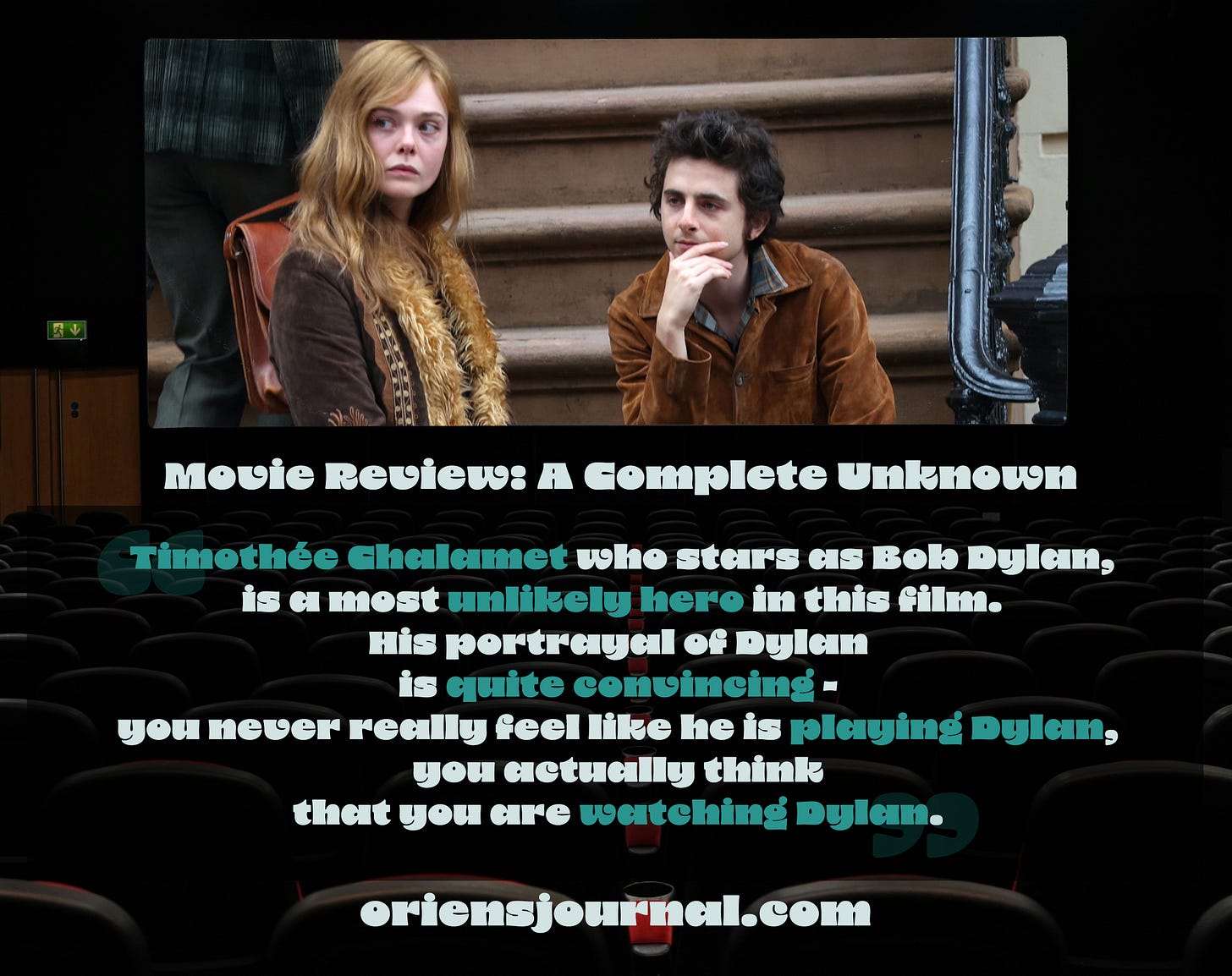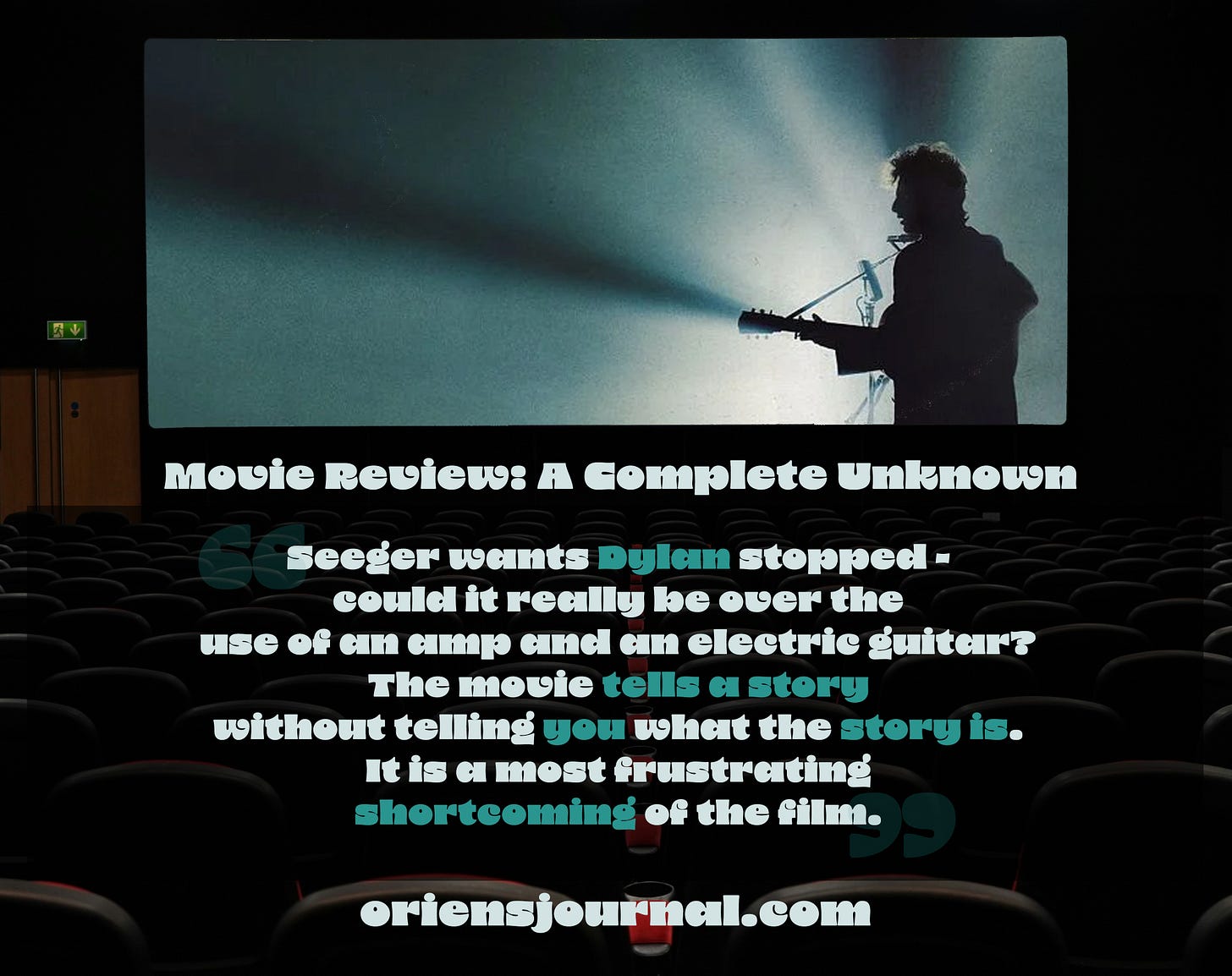
Only artists are going to save the arts. This is the enduring idea of the movie: A Complete Unknown. This probably is a film that many traditionalists overlooked or ignored. A movie about the world’s most famous folk singer very likely triggered memories of guitars, banjos and the inimitable triangle being played at Holy Mass. Shudders run cold up and down the spine as you remember going to church in the 70’s, 80’s and perhaps, depending where you live, of Sunday last. This film is not about that music and its influence per se, rather it is about the influence of politics and the pressure of a distorted world-view that is put upon an artist and his art.
Timothée Chalamet who stars as Bob Dylan, is a most unlikely hero in this film. His portrayal of Dylan is quite convincing- you never really feel like he is playing Dylan, you actually think that you are watching Dylan. The other standout performance in the film is that of Edward Norton who plays Pete Seeger. We are living through a strange moment in the arts. The arts themselves are dead, and cinema has been dying for some time, yet we still have some extraordinarily talented artists all the same. This tells me that talent is not what has changed over the years- rather it is what is inspiring that talent which is so lacking. There is a real possibility of resurrecting the arts, if we can only help those with talent to pursue the greatest ideas and to express them in a way that truly captivates the soul. But herein lies the problem with this film. It is not doubt well directed, very well acted and it is an interesting story; but it is not actually telling the story that it is actually telling. Let me explain.

We all know that the arts express truth in a way that is particular to the arts. The arts do not express truths in propositional form and nor do they appeal to logic in order for you to see what the artist sees. There is always some liberty taken in the expression of those truths. That is as true of the Sistine Chapel as it is for A Complete Unknown. We know that in a biopic film the artist always take certain liberties with time lines and character details in order to tell the story. We can overlook such liberties when they enhance the story or make it clearer without distorting the underlying reality of people and events. A Complete Unknown takes a liberty that actually undoes the story that it is trying to tell.
The premise of the film is simple, a 19-year-old Dylan arrives in New York in 1961 with a guitar and a dream. The film plots his rise to fame and his consequent struggle to adjust to this new life. It shows him to not always be the nicest to those around him, he is at times aloof and standoffish, even to those who want to genuinely love him. He is clearly not just struggling with fame; he is struggling also with something deep within. The film never tells you what it thinks that is, but does drop a few hints along the way as to what it might be. The film ends with his legendary performance in 1965 at the Newport Folk Festival. In the meantime, the film does what is honest- it ignores Dylans’s own political outlook and convictions. But it also does what is unforgivably dishonest to the story- it ignores the politics of those around him. Dylan may have just wanted to write and sing what he felt- those in the world in which he lived, very much believed in the dogma of politicised art.
In a way, the actual sub-plot of A Complete Unknown is the death of art by ideology. Two of the pivotal figures in Dylan’s life in this period are Pete Seegar and Joan Baez, both of whom are avowed political Stalinists and cultural Maoists. The audience is left completely unaware that the fallout between Dylan and Seegar, captured in Seeger’s effort to cut the power to Dylan’s performance at Newport in the film’s climax, was not based on artistic differences or considerations. (There is an excellent article by in the Free Press that explains the details of their falling out.[1]) Seegar expected Dylan to place his talent at the service of the cause. Seeger was an avowed Stalinist who not only defended Stalin without restraint, but who sang songs about him: If I Had a Hammer. Seeger would even leave the US shortly after the famous Newport incident for a tour of the Soviet Union. All this is left unmentioned in the movie. Baez too was someone who wanted Dylan to make his music an instrument of the revolution: the message mattered more than the music. Their falling out was not because Dylan had changed artistically- he would not kowtow politically.
There are two interesting things to note about the film. The first, is that Seegar is a family man. He is shown to be generous to the young Dylan all the while living a very conservative life- he is married with several children[2]. As far as I know, this is historically accurate. This is contrasted to Dylan, who is in the midst of rising fame at the height of the sexual revolution, does all the things that a famous person did in that era. And the film is, by modern standards, quite modest in how it portrays that aspect of the story. Yet the difference between the two is stark. From a traditionalist point of view- Seegar makes the better man in this film.
The second thing to note, is that the subplot in this film is the death of art by ideology. In particular, it highlights the way in which the arts were entirely colonised by progressive secularism under the impetus of cultural Marxism. The problem is- it never gives those forces a name. Seeger wants Dylan stopped- could it really be over the use of an amp and an electric guitar? The movie tells a story without telling you what the story is. It is a most frustrating shortcoming of the film.

However, these two things do not make this a movie you should avoid. It needs a kind of subtitling in order to explain what is happening on the screen. When you know the details of the story, it prevents its one missed truth from becoming a singular lie. I would also personally prefer that the hero of the story were the best character in the story. It seems right that the hero should have the most talent and virtue. However, that is not real life. Talent is blind and oftentimes the hero of the story is flawed. The hero is not the guy without defects, he is the one who has the right virtues at the right moment. Sometimes the Lord relies on a Rehab in his battles, uses a Cyrus to build His temple or sends along a Constantine to free His followers. Just because the hero is not perfect should not turn us away- but give us hope. You too might just be the person with the virtue needed in the right moment. Dylan Is not a perfect character. He is not even the most appealing character in the movie- but he did have that which was most needed at that moment. And what we need right now: backbone.
If we want the arts to transform- we are going to have to transform artists. This needs to be done without censorship and ideology. We don’t need a traditionalist form of artistic censorship. But we do require traditionalists to hand on that received wisdom that has created the greatest art the world has even seen: Western Civilisation. We have the treasure and that treasure is contained in the great ideas of our culture. We just need to surround artists with a world of virtue that inspires the talent they have to become the art we love.
I would recommend this film to anyone who genuinely loves the arts and who is seriously looking for a way to restore them- under the caution however, that he must inform himself about why things happened the way they did.
[1] Moynihan, M., The Truth About Bob Dylan’s Falling Out with Pete Seeger. (https://www.thefp.com/p/truth-about-bob-dylan-pete-seeger-complete-unknown-timothee-chalamet-edward-norton?utm_campaign=post&utm_medium=web)
[2] He and his wife Toshi, would remain married right up until her death in 2013 at age 91.